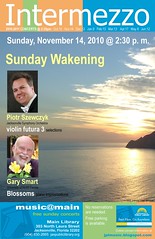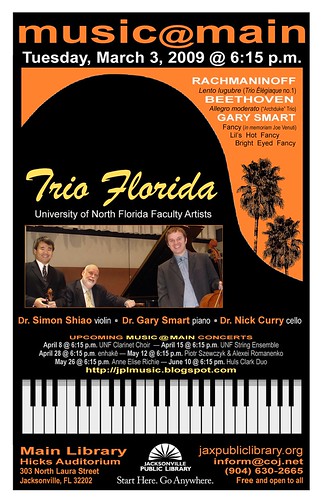University of North Florida Faculty Artists
- Dr. Gary Smart, piano
- Marilyn Smart, soprano
- Dr. Bill Prince, clarinet
- JB Scott, trumpet
- Dave Steinmeyer, trombone
- Dr. Marc Dickman, tuba
MUSICALS SELECTIONS
- Ave Maria (with Brandon Mosley)
- Gary Smart: Improv-fantasy on Christmas Hymns
- Adolphe Adam: O Holy Night (with Marilyn Smart)
- Duo Improvisations on Holiday Favorites
- A Dixieland Christmas (with Bill Prince, JB Scott, Dave Steinmeyer & Marc Dickman)
Gary Smart is a composer, classical and jazz pianist, and teacher, and may be the only pianist to have studied with Yale scholar/keyboardist Ralph Kirkpatrick, the great Cuban virtuoso Jorge Bolet, and the master jazz pianist Oscar Peterson. Smart’s work has been supported by the Guggenheim Foundation, the Ford Foundation, the Music Educator's National Conference, the Music Teacher's National Association and the National Endowment for the Arts, and has been performed in major venues in the U.S., Europe and Asia. Dr. Smart's compositions are published by Margun Music (G. Schirmer) and his work has been recorded on the Capstone and Albany labels. He spent two residencies in Japan, and taught in Indonesia as "Distinguished Lecturer in Jazz" under the auspices of the Fulbright program. Gary Smart is currently a Presidential Professor of Music at the University of North Florida, where he served as Chairman of the Music Department from 1999-2003.
Brandon F. Mosley, clarinetist, is a Music Performance major at the University of North Florida. An active member of the school’s top ensembles, he has performed as soloist with the Jacksonville Symphony Orchestra and the UNF Wind Symphony. He has given master classes at Fletcher High school, NFC summer camp and UNF summer camp. In 2013, Brandon participated in the prestigious Vianden International Music Festival located in Luxembourg. This fall he was a finalist in the Northwest Florida Concerto Competition. He is a proud recipient of numerous scholarships, some of which include the Adam W. Herbert scholarship and the Tonsfeldt Music Scholarship, in addition to Florida Bright Futures. He currently studies with Dr. Sunshine Simmons, and past teachers have included the Jacksonville Symphony's principal clarinetist Peter Wright, Dr. Guy Yehuda and Dr. Boja Kragulj. Brandon is an active freelancer, performing at various churches and venues around the city of Jacksonville.
The musical career of Marilyn Smart has been both active and diverse. She has worked with such luminaries as Robert Shaw, Seiji Ozawa, and Dave Brubeck, and has sung in unique venues in Europe, Asia, and the United States. Smart’s singing has delighted audiences not only in public and university concert halls, but also in rural American schools, special cultural outreach venues in Japan, and even Eskimos villages in northern Alaska. Awarded a special citation by the Ford Foundation's Contemporary Music Project, she has long championed the work of contemporary composers and, with her husband, composer-pianist Gary Smart, is recognized for their performances of American art song. A former student of Margaret Harshaw, Josef Metternich, and Phyllis Curtin, Smart has taught at the University of Wyoming, Kobe College, and Osaka University. Since joining the faculty of UNF in 1999, she has performed as soloist with the Jacksonville Symphony Orchestra, for the Friday Musicale, the St. Cecelia Society, and many other local musical organizations. At UNF, Marilyn Smart teaches Applied Voice, French, Italian, and German Diction, as well as Vocal Literature.
Bill Prince, professor emeritus at the University of North Florida, has performed with numerous bands and orchestras including Buddy Rich, Billy Maxted, Pee Wee Hunt, the NORAD Band, the Denver, Ft. Lauderdale, Palm Beach and Jacksonville Symphonies, the American Wind Symphony Orchestra, Xavier Cugat, Ray Anthony, Tex Beneke, Les and Larry Elgart, Harry James, Tommy Dorsey, and Louis Bellson. He has appeared in televised broadcasts in the United States, Canada, Japan, the Philippines, Costa Rica, Colombia and Ecuador, and has performed on over 70 albums including his "The Best Kept Secret in Jazz." His performing instruments include trumpet, flugelhorn, trombone, flute, clarinet, saxophone, piano, and electric bass. For his own CD, "Happy Thoughts," he composed, arranged and performed all the parts himself. Bill holds the Doctor of Musical Arts degree with a major in Theory and Composition from the University of Miami. He has taught at Florida Atlantic U, the U of Colorado/Denver, St. Francis Xavier U, Nova Scotia, the U of North Florida, and served as a visiting lecturer in South Africa. Dr. Prince has appeared in all 50 states and 80 countries, and his compositions and arrangements have been performed and recorded by professional and student jazz ensembles throughout the United States and Canada.
When he received his B.A. in Music, J.B. Scott became the first graduate of the acclaimed jazz program at the University of North Florida; he later earned an M.S. Degree in Music Ed. at Florida International University. While still in college he performed with the Jimmy Dorsey Orchestra, toured Japan with the Ringling Bros. and Barnum & Bailey Circus, and performed regularly in the Walt Disney World theme parks. He did a three year stint with the Dukes of Dixieland and was featured in the PBS special, "Salute to Jelly Roll Morton." He has performed professionally with the Mickey Finn Show and numerous Latin bands led by such legends as Eddie Palmieri, Paquito D'Rivera and Arturo Sandoval. Now Associate Professor of Jazz Studies at UNF, he is President-elect of Florida Jazz Educators and a member of both JEN (Jazz Education Network) of MENC and the Florida Band Masters Association. Prof. Scott was a member of the International Association of Jazz Educators for 20 years, serving as the IAJE Florida Secretary for six of them. In addition to numerous international solo engagements, he has been featured in TV and radio commercials, and has released several successful CDs with vocalist Lisa Kelly. Prof. Scott is highly regarded as an adjudicator and guest artist/clinician for secondary to collegiate music programs, competitions and music camps.
Dave Steinmeyer, trombone, spent 28 years as a musician in the United States Air Force, with 24 of those years playing lead trombone with the world famous Airmen of Note (the big band started by Glenn Miller) and the last 10 years of his tenure as the “Note’s” director. During his days with the “Note” the band traveled to Los Angeles three times a year to record albums with famous musicians including Sarah Vaughn, Joe Williams, Rosemary Clooney, Frank Sinatra, Patrick Williams, J.J. Johnson, Lou Rawls and Diane Schuur. Dave has appeared as a performer and clinician at most of the major universities in the United States, and he has performed for eight United States Presidents. Dave has been a featured artist at the Sydney Opera House in Australia, the Kennedy Center and the White House, and has appeared on numerous television productions and studio projects. In addition to receiving the Lowell Mason Award for Education, Dave is an Adjunct Professor of Applied Trombone at the University of North Florida School of Music in Jacksonville.
Dr. Marc Dickman, from Valdosta, Georgia, is a founding member of the acclaimed Jazz Studies Program at the University of North Florida. Dr. Dickman earned degrees from Troy State University, McNeese State University, and the University of North Texas. His versatility on euphonium, trombone, bass-trombone and tuba in both classical and jazz styles places him in much demand in the United States. At UNF he teaches applied low brass and jazz ensemble. His students have won awards in the jazz and classical areas. Dr. Dickman was a featured jazz artist at the 2000 International Tuba Euphonium Conference in Regina, Saskatchewan, Canada, the 2001 ITEC in Lahti, Finland, the 2002 ITEC in Greenville, NC, and the 2004 ITEC in Budapest, Hungary, and the 2005 and 2008 U.S. Army Tuba Euphonium Conference. Dr. Dickman is a founding member of the groundbreaking jazz ensemble, the Modern Jazz Tuba Project. The MJT Project has two critically acclaimed releases: "Live From the Bottom Line" and "Favorite Things." Marc's CD, "A Weaver of Dreams,"is the first jazz euphonium recording to be available through popular services such as iTunes and Real Networks. Dr. Dickman has performed in the USA, Japan, Finland, Hungary, Paraguay, Uruguay, Canada, Honduras and Columbia.























